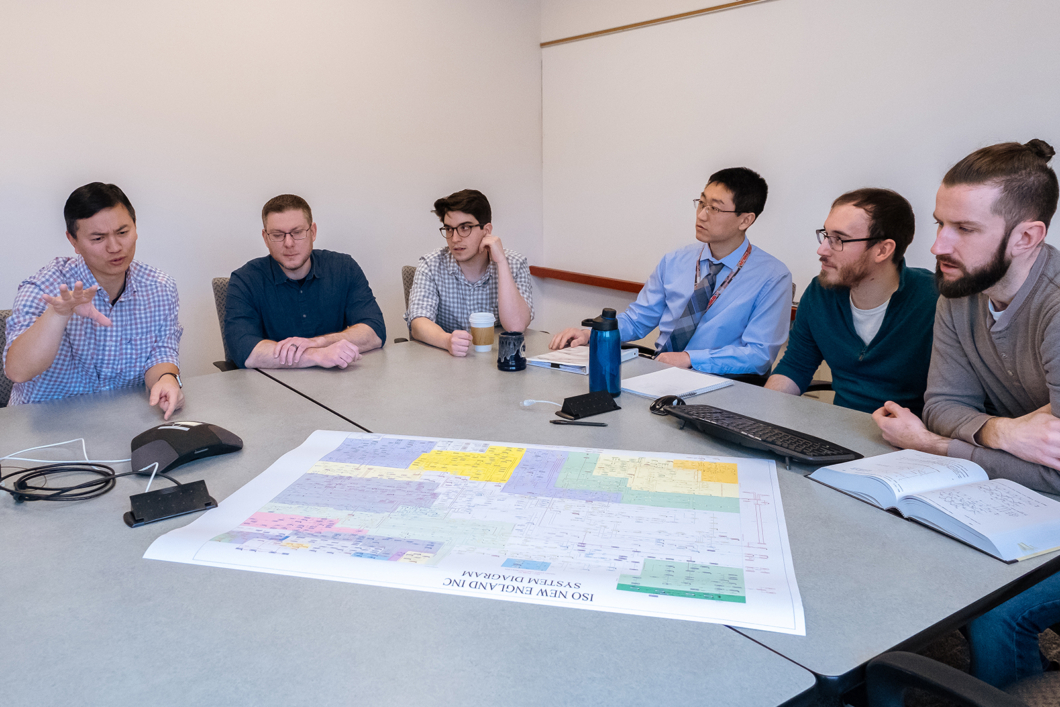Clean energy transition focus of trailblazing ISO-NE team

The more wind, solar, and battery storage resources come online, the more challenging it will be for grid operators to balance electricity supply and demand in real time. Exploring this uncharted aspect of the clean energy transition is a team of engineers and analysts at ISO New England.
The Electromagnetic Transient Working Group—made up of Xinghao Fang, David Hussey, Bradley Marszalkowski, Jason Ploof, Zachary Serritella, and Frankie Zhang—was recently honored with ISO New England’s CEO Award for Innovation. Members represent the ISO’s Operations Support Services, Transmission Service Studies, and Advanced Technology Solutions departments.
“These engineers work hard, learn fast, and are really good at working with other industry talents on addressing pressing challenges,” said Fang, supervisor of Operations Technical Studies. “They have a strong passion for technology advancement and the clean energy transition. They are also extremely excited to witness the unprecedented grid transition, and more importantly to be part of the community who makes that happen.”
The team’s work will help ensure New England’s electricity is not only increasingly clean, but also reliable and cost-competitive. And its discoveries are expected to extend beyond ISO New England and its stakeholders, benefiting other regional transmission organizations and the electricity industry as a whole.
From an engineering perspective, clean energy resources differ fundamentally from the conventional power plants that have provided most of the region’s electricity for decades. Clean energy resources produce electricity that flows in one direction (direct current). That means they need an extra piece of equipment called an inverter to interface with the grid, where electricity switches direction 60 times every second (alternating current). Inverter-based resources make up a relatively small portion of New England’s resource mix today—roughly 9,800 megawatts (MW)—but that is expected to change dramatically in the coming years. By the end of the decade, the ISO predicts there will be about 11,000 MW of solar power alone. Inverter-based resources make up a majority of proposed projects in the ISO Interconnection Request Queue, including nearly 16,000 MW of wind and 11,000 MW of battery storage. Not all proposed projects end up being built. The ISO is also preparing for the possibility of 3,400 MW in high-voltage direct current interconnections to Canadian hydropower.

Getting all those new resources to blend into the grid harmoniously will require thorough planning. Recent events have demonstrated the potential reliability issues posed by a greater penetration of inverter-based resources. California and Texas have each had grid disturbances cause large amounts of solar or wind resources to trip offline unexpectedly, forcing system operators to scramble to keep supply and demand in balance.
Disturbances can be caused by lightning strikes or high winds interrupting the flow of power on the transmission system. Conventional generating resources usually can “ride through” such disturbances without problems. But that’s not always the case for inverter-based resources, which have protective systems that can be sensitive to disturbances, necessitating further study.
The most challenging scenarios for power system reliability involve sunny or windy conditions, when inverter-based resources are most active. If they were to suddenly stop working, there might not be enough reserve resources to immediately pick up the slack. That could lead to significant power outages and serious equipment damage.
“The work we are doing in the Electromagnetic Transient Working Group, although only a first step, is allowing us to get ahead of those problems,” said Marszalkowski.
Specifically, this interdisciplinary team has made two key innovations: developing a comprehensive management process for all computer models that represent how each inverter-based resource interacts with the grid, and optimizing software programs and hardware used to run computer simulations based on those models.
“Both of them are breakthrough work for the industry,” Fang said. “Once we are able to replicate it in the computer simulation, we should have a better understanding of the likely causes for this kind of undesirable behavior,” he said of inverter-based resources tripping offline. “Then we can put proper operational measures or limitations in place to prevent that from happening.”

Traditionally, power systems are modeled using a technique called transient stability analysis. While that approach is well-suited to studying conventional resources, it’s not detailed enough to accurately capture the behavior characteristics of inverter-based resources.
Another technique, called electromagnetic transient (EMT) analysis, provides the necessary level of detail but takes significantly more time to produce results. Where a transient stability simulation can be completed in about 15 minutes, the greater detail in EMT simulations means they can take dozens of hours. But by testing EMT software extensively with different hardware configurations, the working group found ways to complete most simulations within an hour.
Both methods involve taking many sequential “snapshots” of simulated power system conditions over a given period. Transient stability analysis measures conditions at 4-millisecond intervals. Electromagnetic transient analysis operates on a timescale 200 times smaller—taking a measurement every 20 microseconds. In other words, a transient stability study simulating a 15-second event would produce 3,750 snapshots, while an EMT simulation would produce 750,000 snapshots of the same 15-second event.
ISO-NE engineers could begin applying the working group’s innovations to real-world planning and operations studies as soon as this year. In the long run, Electromagnetic Transient Working Group members hope their efforts will not only aid system planners and operators, but also benefit the whole power industry in expediting the clean energy transition while striving for an even more stable grid.
“Being able to push the frontiers of EMT modeling and simulation and help the clean energy transition make me proud,” said Zhang.



